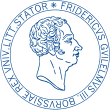Friedrich Heimsoeth
Friedrich Heimsoeth (born February 11, 1814 in Cologne , † October 16, 1877 in Bonn ) was a German classical philologist , art historian and musicologist. He also excelled as an art collector.
Live and act
Friedrich Heimsoeth, the son of the Justizrathes Marcus Heimsoeth and his wife Elisabeth de Noel, attended the Friedrich-Wilhelm-Gymnasium in Cologne and moved to the University of Bonn in 1831 , where he studied classical studies and philosophy. Friedrich Gottlieb Welcker and August Wilhelm Schlegel were among his teachers . In 1835 Heimsoeth received his doctorate with the dissertation Democriti de anima doctrina , in which he created a glossary and a collection of fragments in addition to the theory of the soul of the Greek philosopher Democritus . As a private lecturer, he completed his habilitation in 1837.
In his young scholarly years, Heimsoeth became acquainted with the archaeologist and collector Sibylle Mertens-Schaaffhausen . Like his mother's brother, Mertens-Schaffhausen also stimulated his passion for collecting and his inclination for the fine arts. In 1843 he married their daughter. Heimsoeth was a lover of the older classical and, above all, church music, which he brought closer to a broad audience through performances in private and public settings in Bonn, both as a choir singer and as a conductor. He also wrote a work on Ludwig van Beethoven's missa solennis (1845). Heimsoeth also began an active collection of old etchings and contemporary copperplate engravings. Later he also collected hand drawings by old masters. For the auction of the collections of the art dealer Hermann Weber (1855) and his mother-in-law (1857), Heimsoeth published catalogs that were highly regarded in art historical circles.
On October 18, 1848 Heimsoeth was appointed associate professor of classical philology at the University of Bonn . After Friedrich Ritschl left in May 1865 (after the philologists' dispute with Otto Jahn in Bonn ), Heimsoeth was appointed full professor and promoted to the chair of eloquence in the course of the necessary restructuring in the philosophy faculty on December 30th of that year. After Otto Jahn's death, Heimsoeth joined the management of the Bonn Philological Seminary. In the academic year 1869/70 he was also rector of the University of Bonn.
Heimsoeth's health has been marred by illness and stroke of fate during his years as a professor. In 1866 he suffered from a breast disease from the consequences of which he never fully recovered. In 1874 a son of Heimsoeth died, and Heimsoeth was unable to recover despite the care of his family and a few spa stays in Italy. Shortly before the beginning of the winter semester 1877/78 he died of a hemorrhage. His considerable collection of old prints was auctioned off by the art dealer Ferdinand August Christian Prestel .
Heimsoeth's research and teaching as a philologist was shaped by his sophisticated taste in art. He valued only a few authors whom he exclusively deals with in his courses and academic work: Pindar , the Attic tragedians ( Aeschylus , Sophocles , Euripides ) and Plato in Greek, Horace and Tacitus in Latin. Through intensive occupation, he gained a secure feeling for their use of language, which, however, also led him astray in textual criticism . Research meant a quiet activity for him, his publications were only a by-product. "Invitus scripsi, nam discendi suavior multo quam scribendi labor." ("I wrote involuntarily, because learning is a more pleasant job than writing.") He wrote in his first independent work ( Addenda et corrigenda in commentariis Pindari , 1840, p. 71 ).
Thematically, his work dealt with problems of textual criticism and metrics in general and with Aeschylus and Pindar in particular. Heimsoeth's central work is The Restoration of the Dramas of Aeschylus (Bonn 1861), in which he provided the reason for a critical emendation of the Aeschylic tragedies. His work on metrics was not only mathematical, but also clearly aesthetic ( The Truth About the Rhythm in the Chants of the Ancient Greeks, together with an appendix on the performance of Greek chants , 1846) and was always up to date ( Ueber die latest metric theory , 1850).
His daughter Sibylla married the Bonn musicologist and high school teacher Hermann Deiters (1833–1907) in 1886 .
literature
- Hermann Usener : Heimsoeth, Friedrich . In: Allgemeine Deutsche Biographie (ADB). Volume 11, Duncker & Humblot, Leipzig 1880, pp. 333-335.
Web links
- Literature by and about Friedrich Heimsoeth in the catalog of the Lower Saxony State and University Library Göttingen
- Speeches by Friedrich Heimsoeth at the Historical Commission of the Bavarian Academy of Sciences
Individual evidence
- ^ Hermann Usener: Heimsoeth, Friedrich . In: Allgemeine Deutsche Biographie (ADB). Volume 11, Duncker & Humblot, Leipzig 1880, pp. 333-335.
| personal data | |
|---|---|
| SURNAME | Heimsoeth, Friedrich |
| BRIEF DESCRIPTION | German classical philologist, art historian, collector, musicologist |
| DATE OF BIRTH | February 11, 1814 |
| PLACE OF BIRTH | Cologne |
| DATE OF DEATH | October 16, 1877 |
| Place of death | Bonn |
